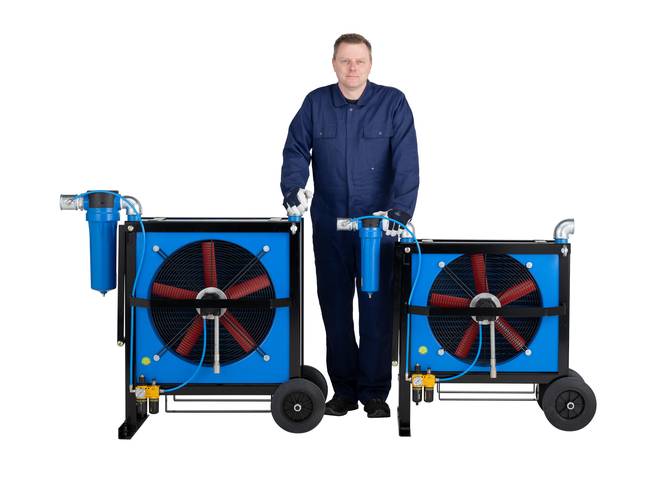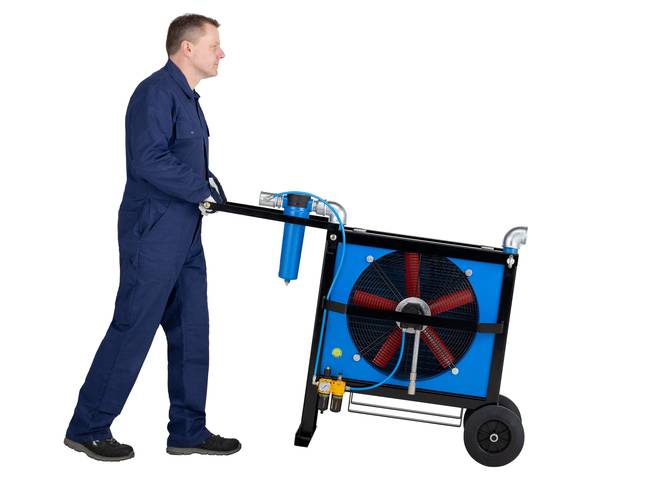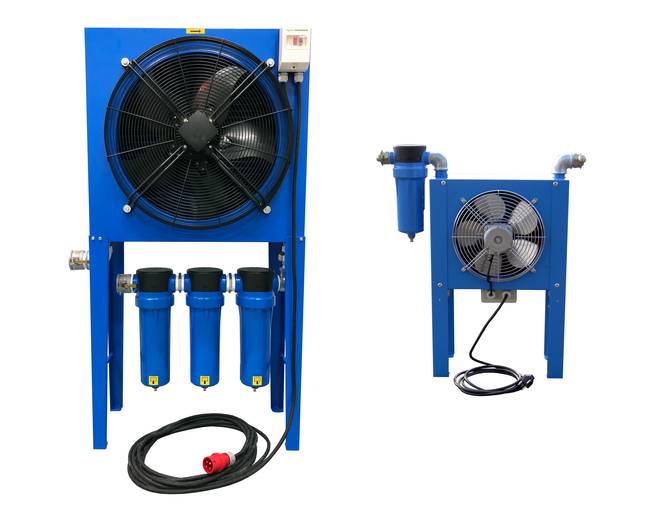Compressed air aftercoolers
Problem-free blasting with high-quality surface results starts with dry compressed air. Gritco's extensive range of compressed air aftercoolers is specially developed to get the best possible compressed air for all types of blasting systems.
Free tailor-made advice
No standard solutions, but tailor-made solutions for every sector. Our experience guarantees the perfect solution for your needs. Wondering which aftercooler will help you blast better and more efficiently?
Cooling/drying/filtering
To achieve an even abrasive flow and avoid blockages and machine problems, moisture must be removed from the compressed air. Clean and dry compressed air also improves the quality of the blasted surface for subsequent production processes such as paint spraying.
With an aftercooler, the compressed air from the compressor is cooled to about 9˚C above ambient temperature. This temperature drop causes moisture to condense and form droplets. These droplets are then removed by the centrifugal separator. For even better compressed air quality - free of oil and other contaminants - additional compressed air filters can be fitted.
Powerful advantages
- Trouble-free blasting thanks to 80 - 85% drier compressed air
- Reduced abrasive consumption due to improved metering capabilities with a constant, even abrasive flow
- Prevents costly, poor blasting results caused by moist compressed air
- Models with nominal capacities from 1 to 25 m³
- Top-quality heat exchanger with copper pipes and aluminium fins
Versions
Our compressed air aftercoolers are versatile and can be adapted to your specific needs. They are equipped with an air motor for the fan, allowing them to be used in any location. Depending on the model, electric versions at 400V, 240V or 12V are also possible.
We offer various frame options for easy transport and use in various locations. These frames also provide protection for the motor and aftercooler cooling fins, keeping your investment well protected.
The aftercooler can be expanded with a filter set (1 & 0.01 microns) for the highest compressed air quality and can be equipped with an automatic drain system to remove moisture and contamination from the compressed air.
Frequently asked questions
-
What should you consider when buying a compressed air aftercooler?
The most important aspect of an aftercooler is that it sufficiently cools down the compressed air. This should be a maximum of 9 degrees compared to the ambient air (Delta T = 9). If this difference is greater, not enough moisture is condensed which can be separated. As a result, further cooling of the compressed air takes place in the blast pot, which will lead to moisture problems.
In addition, it is essential that the capacity of the cooler and moisture separator matches the actual compressed air demand. A too large or too small model can still cause humidity problems in the blasting process.
-
Is a built-in aftercooler of the compressor also sufficient?
Only if it has a Delta T of 9 degrees or lower. With most leading compressor brands, this is usually the case. Please note that sometimes the built-in cooler is also used to cool the compressor oil, which can lead to insufficient cooling capacity for the compressed air and therefore moisture problems in the blast pot. Therefore, always ask your compressor supplier about the Delta T of the aftercooler.
-
Pneumatic or electric model: what to choose?
A pneumatic model can easily be used anywhere, as compressed air is always available. However, pay attention to the compressed air consumption of the fan's air motor. In situations where compressor capacity is critical, an electric model may be the way to go. In stationary setups, an electric model is also often preferable due to lower consumption costs.
-
When is the additional filter set advisable?
The finer the abrasive, the more important the quality of the compressed air becomes to prevent blockages in the blast pot. The aftercooler's moisture separator removes most of the moisture. The additional filters of 1 and 0.01 microns remove not only the last remaining moisture, but also oil traces from the compressor. Especially with older (rental) compressors, this can be an extra advantage as they often let more oil through.
Request a free proposal
Every company is unique and every blasting application requires an individual approach. Therefore, we are happy to offer a free machine proposal tailored specifically to your needs.



